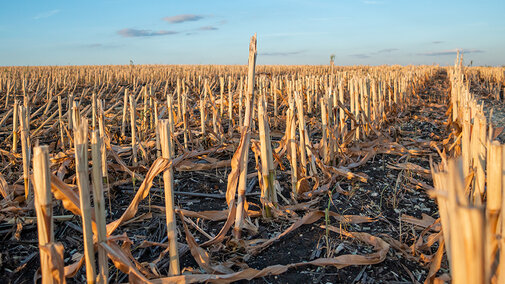Corn Silage Harvest
Silage harvest for fully irrigated full-season corn usually begins 45 days or 800 GDDs after the tassel/silking growth stage. However, growing conditions and the season length of the plant itself can make predictions based on the calendar fuzzy at best.
Accurately assessing whole plant moisture is key to proper silage pile fermentation and tight packing. If silage is too dry, packing is difficult and may allow oxygen into the pile, causing overheating, mold/yeast/bad microbe growth, and spoilage. When the silage moisture content is too high, piles can weep with valuable energy and nutrients flowing out as a loss from the pile. Also, damaging clostridia bacteria colonies can grow when silage is too wet. Target silage storage moisture content should be 65-70% moisture.
Another factor to consider for silage chopping is milk line (a corn kernel starch content indicator). Starch is one of the most energy-dense feed components, so silage that contains higher amounts of starch will be higher energy overall. The further down the kernel milk line is established, the more starch content has been stored in the kernel.
Plant moisture and milk line may not be directly correlated and may vary among hybrids. While these development factors trend in the same direction, the moisture content may vary from field to field, even if milk line is the same.
Corn silage is a great feed resource that can benefit from moisture content monitoring at harvest. Target harvesting silage at 65-70% moisture content for best results. Use the ear kernel milk line (closer to the cob means more starch and higher energy silage) to find your ideal harvest window based on your hybrids.
Cover Crops Following Corn Silage
Following corn silage harvest, your ground can lay bare for seven to nine months. Instead, let’s plant some crops to grow and cover it until next season.
After silage harvest, bare ground has three things working against it. One is exposure to wind and water erosion. Secondly, bare soils lack growing roots, which are needed to feed the living soil-building microbes. Finally, bare soils represent a missed opportunity to grow cover crops that might help you overcome all these problems.
But what should you plant? If you are hoping for some feed this fall, then oats, spring triticale and barley, annual ryegrass and turnips might be a good choice because these plants have the greatest forage yield potential yet this fall. Spring oats, triticale and barley also will die over winter, so they won’t interfere with next year’s crop. However, getting these non-winter hardy annuals seeded as early as possible in September is needed to have time to grow an adequate amount of fall forage.
Winter rye is the most common choice among the cereals, and cereal rye can provide abundant grazable growth early next spring to get cows off hay sooner. Wheat and triticale also can be good cover crops. Wheat then can be harvested later for grain, while triticale makes very good late spring forage. The seeding date window for the winter cereals can extend well into October, but earlier seeding will allow for more fall growth. Legumes like hairy vetch or winter peas could also be planted as part of a mixture with the winter annual cereals.
Cover crops can preserve or even improve your soil and can be useful forages as well. Consider them following your early harvests.
PRF as a Risk Management Tool
Pasture and forage are the foundation of many Nebraska livestock operations, but they’re also one of the most vulnerable resources. Drought can quickly reduce forage production, forcing ranchers to buy expensive feed or reduce herd numbers.
One tool producers can use to manage this risk is USDA’s Pasture, Rangeland and Forage (PRF) Insurance. Unlike traditional crop insurance, PRF doesn’t insure the actual forage you grow. Instead, it’s based on a rainfall index for your area. If rainfall falls below the long-term average during the months you select, you may receive an indemnity payment.
These indemnities are designed to help offset the added costs of purchasing hay, feed or other supplements when pasture growth is limited. In other words, PRF helps stabilize cash flow in dry years, giving ranchers more flexibility to maintain their herd and avoid making short-term decisions that can have long-term consequences.
Enrollment for PRF happens annually before Dec. 1, with coverage based on your county and your chosen grazing or haying months. While it doesn’t guarantee a profit, it is a valuable tool to include in your risk management plan, especially as weather patterns remain unpredictable.
For more information, visit UNL CAP or talk with your local crop insurance agent.

